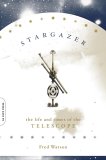Summary | Excerpt | Reviews | Beyond the Book | Readalikes | Genres & Themes | Author Bio

Critics' Opinion:
Readers' Opinion:
First Published:
Jul 2005, 360 pages
Paperback:
Jun 2006, 352 pages
 Book Reviewed by:
Book Reviewed by:
BookBrowse Review Team
Buy This Book
It has to be said that it was not so much the directors and
project managers of the new facilities who were responsible for fostering this
view. Nor was it the organisers of the symposium. But aperture fever stalked the
corridors and halls of the International Congress Centre like a prowling tiger,
and voices could be heard urging radical cuts in the funding of telescopes that
had until recently been among the world's largest.
The organisers of the symposium had clearly attempted to defuse
the issue through the way they had programmed the meetings. Their view was that
there is still so much to be learned about the Universe, both near and far, that
every telescope pointing to the sky has a valid and useful part to play. As long
as the funding can stretch that far, they should all be utilised. And what made
that view so evident was the prominence they had given to the symposium's other
major attraction—the presentations on auxiliary instrumentation.
The field of astronomical instrumentation is one that rewards
clever and innovative thinking without incurring the enormous costs of new
telescopes. Typically, it involves dazzling technology of the kind used in
adaptive optics. But it extends far beyond that limited area. For example,
imagine a spectrograph that can compensate for poor atmospheric conditions by
allowing not one but hundreds of objects to be observed at a time. It would
allow a 4-metre class telescope on an indifferent site to explore novel and
quite unique niches of astronomical research. That is exactly the approach that
had been taken during the 1990s with the 3.9 metre Anglo-Australian Telescope at
Siding Spring Observatory, one of the oldest of the 4-metre class machines,
dating from 1974.
Innovative instrumentation can revitalise old-fashioned
telescopes and transform them into giants of astronomical productivity. It is
the real equaliser in the balance of telescope superiority—and the true antidote
of aperture fever. 'Power Telescopes and Instrumentation into the New
Millennium' boasted no fewer than 160 presentations on auxiliary instruments for
ground-based telescopes, and another 100 on adaptive optics. One might have
thought that this kind of prominence would have averted an aperture fever
epidemic altogether.
And indeed, it almost did.
Starving the fever
Half a world away, on a mountain peak in Chile called Cerro
Paranal, the world's biggest optical telescope was in its final stages of
assembly. This giant instrument, being built by the European Southern
Observatory, incorporated four separate 8-metre class telescopes that could be
used independently or linked together to mimic a single 16 metre dish. Three of
them were already in operation. For all the linguistic elegance of the European
partnership that had given it life, it sported a very ordinary name. It was, and
remains, the VLT—the Very Large Telescope.
Even as the VLT was being built, there was talk of still larger
telescopes. At the last European conference on optical telescopes, four years
earlier, a handful of proposals for amazing instruments with much larger mirrors
had been presented. One had been called the ELT—the Extremely Large
Telescope—and the name had stuck as a generic term for a new telescope class:
ones with mirrors 25 metres in diameter. Mirrors for these giants would not be
made from single slabs of glass but from assemblies of smaller pieces under
computer control—the now-proven segmented-mirror technology.
The thinking that had raised eyebrows in 1996 had become
commonplace by 2000—'from wild to mild', as one participant put it. It had
brought with it a whole new vocabulary of telescope names. For example, Caltech
offered CELT (the California Extremely Large Telescope), while a Swedish
university consortium championed SELT (the Swedish Extremely Large
Telescope—which has since been renamed Euro50). On the other hand, the somewhat
pretentious MAXAT (the Maximum Aperture Telescope) was about to be discarded in
favour of the GSMT (the Giant Segmented-Mirror Telescope) by its own
enthusiastic proponents. Enthusiasm notwithstanding, none of these proposals had
got remotely near the construction stage and only CELT had any real prospect of
being funded in the near future.
From Stargazer by Fred Watson, pages viii - x of the Prologue, and pages 1-17 of Chapter 1. Copyright Fred Watson. All rights reserved. Excerpt reproduced by permission of Da Capo Press.





The Flower Sisters
by Michelle Collins Anderson
From the new Fannie Flagg of the Ozarks, a richly-woven story of family, forgiveness, and reinvention.

The House on Biscayne Bay
by Chanel Cleeton
As death stalks a gothic mansion in Miami, the lives of two women intertwine as the past and present collide.

The Funeral Cryer by Wenyan Lu
Debut novelist Wenyan Lu brings us this witty yet profound story about one woman's midlife reawakening in contemporary rural China.
Your guide toexceptional books
BookBrowse seeks out and recommends the best in contemporary fiction and nonfiction—books that not only engage and entertain but also deepen our understanding of ourselves and the world around us.